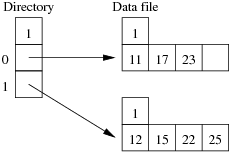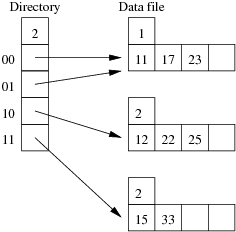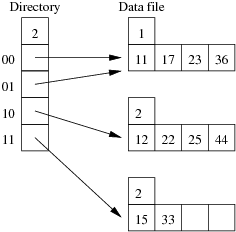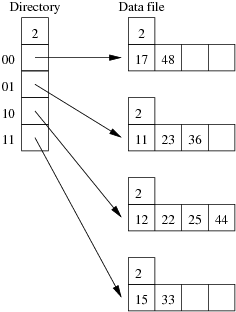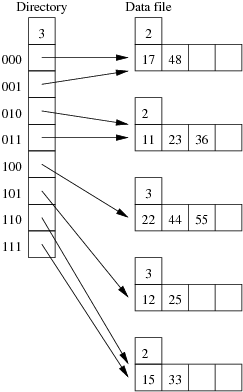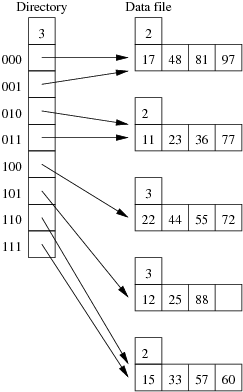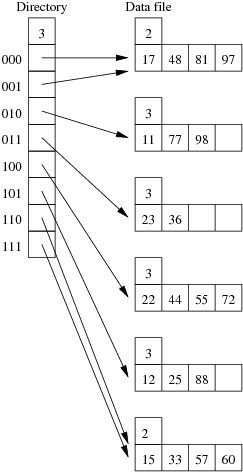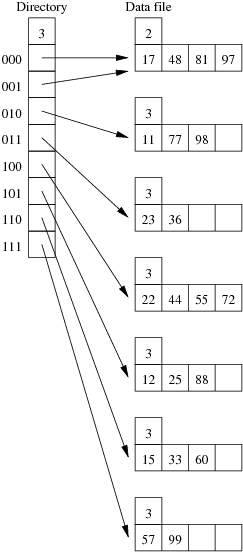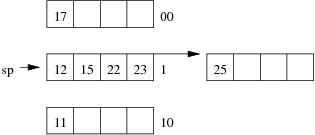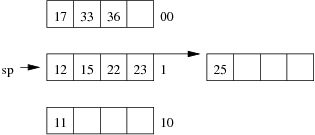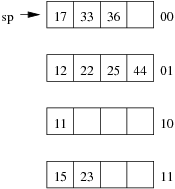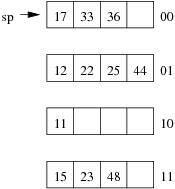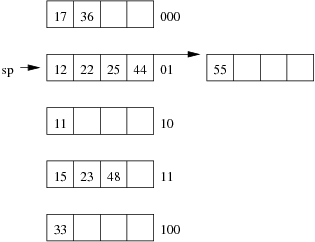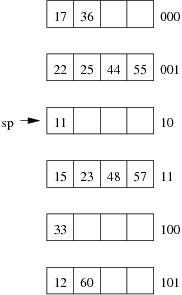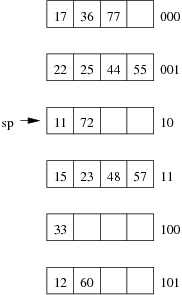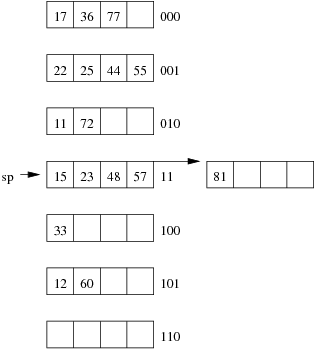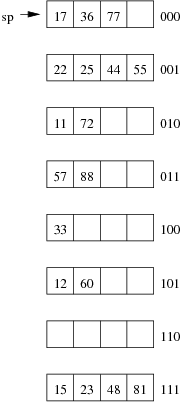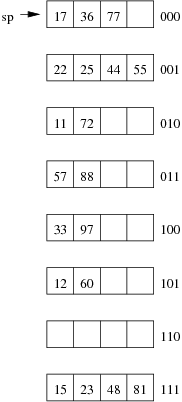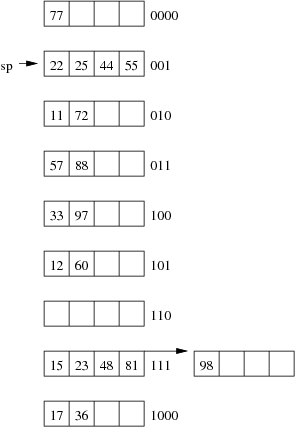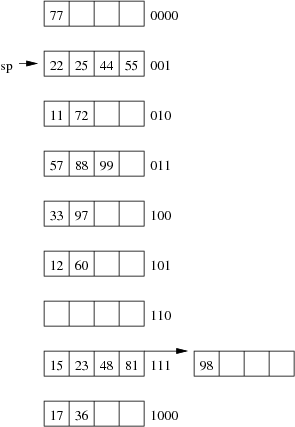Consider the relations:
Student(id#, name, age, course) Subject(code, title, description)
Make the following assumptions:
- rStudent = 50,000, rSubject = 5,000
- the data file for
Studentis sorted onid#, the data file forSubjectis sorted oncode - simple one-level indexes are used (e.g. because the files are reasonably static)
- record IDs (RIDs) are 4-bytes long
- all data pages and index pages are 4KB long
Based on these assumptions, answer the following:
-
You can build a dense index on any field. Why?
-
On which field(s) could you build a non-dense index?
If the student id# is a 4-byte quantity, how large would a dense index on
Student.id#be?If the subject code is an 8-byte quantity, how large would a dense index on
Subject.codebe?If the cStudent = 100 and cSubject = 20, and other values are as above, how large would non-dense indexes on
Student.id#andSubject.codebe?If you had just dense indexes on
Student.id#andSubject.code, briefly describe efficient processing strategies for the following queries:-
select name from Student where id=2233445 -
select title from Subject where code >= 'COMP1000' and code < 'COMP2000' -
select id#,name from Student where age=18 -
select code,title from Subject where title like '%Comput%'
-
What techniques could you use to improve the performance of each of the above queries? And how would it impact the other queries?
Consider a relation R(a,b,c,d,e) containing 5,000,000 records, where each data page of the relation holds 10 records. R is organized as a sorted file with the search key R.a. Assume that R.a is a candidate key of R, with values lying in the range 0 to 4,999,999.
Determine which of the following approaches to evaluating the relational algebra expression πa,b(σa>50000(R)) is likely to be the cheapest (minimum disk I/O):
- Use a clustered B+ tree index on attribute R.a.
- Use a linear hashed index on attribute R.a.
- Use a clustered B+ tree index on attributes (R.a,R.b).
- Use a linear hashed index on attributes (R.a,R.b).
- Use an unclustered B+ tree index on attribute R.b.
- Access the sorted file for R directly.
Consider the following example file organisation using extendible hashing. Records are inserted into the file based on single letter keys (only the keys are shown in the diagram).
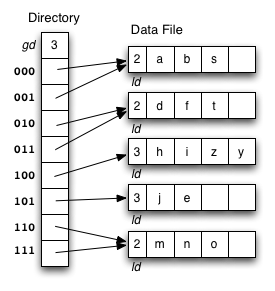
The dictionary contains a "global depth" value (gd), which indicates how many hash bits are being considered in locating data pages via the dictionary. In this example, the depth gd=3 and so the dictionary is size 2gd=2d=8.
Each data page is marked with a "local depth" value (ld), which
indicates the effective number of bits that have been used to place
records in that page. The first data page, for example, has ld=2,
which tells us that only the first two bits of the hash value were used
to place records there (and these two bits were 00).
The third data page, on the other hand, has ld=3, so we know that
all records in that page have their first three hash bits as 100.
Using the above example to clarify, answer the following questions about extendible hashing:
-
Under what circumstances must we double the size of the directory, when we add a new data page?
-
Under what circumstances can we add a new data page without doubling the size of the directory?
- After an insertion that causes the directory size to double, how many data pages have exactly one directory entry pointing to them?
- Under what circumstances would we need overflow pages in an extendible hashing file?
- What are the best-case and worst-case scenarios for space utilisation in the dictionary and the data pages (assuming that there are no overflow pages)? Under what circumstances do these scenarios occur?
Consider the following example file organisation using linear hashing. Records are inserted into the file based on single letter keys (only the keys are shown in the diagram).

Using the above example to clarify, answer the following questions about linear hashing:
-
How is it that linear hashing provides an average case search cost of only slightly more than one page read, given that overflow pages are part of its data structure?
-
Under what circumstances will the average overflow chain length (Ov) not be reduced during page splitting?
- If a linear hashing file holds r records, with C records per page and with splitting after every k inserts, what is the worst-case cost for an equality search, and under what conditions does this occur?
Consider the following employee relation:
Employee(id#:integer, name:string, dept:string, pay:real)
and some records from this relation for a small company:
(11, 'I. M. Rich', 'Admin', 99000.00) (12, 'John Smith', 'Sales', 55000.00) (15, 'John Brown', 'Accounts', 35000.00) (17, 'Jane Dawes', 'Sales', 50000.00) (22, 'James Gray', 'Sales', 65000.00) (23, 'Bill Gates', 'Sales', 35000.00) (25, 'Jim Morris', 'Admin', 35000.00) (33, 'A. D. Mine', 'Admin', 90000.00) (36, 'Peter Pipe', 'R+D', 30000.00) (44, 'Jane Brown', 'R+D', 30000.00) (48, 'Alex Brown', 'Plant', 40000.00) (55, 'Mario Reid', 'Accounts', 27000.00) (57, 'Jack Smith', 'Plant', 35000.00) (60, 'Jack Brown', 'Plant', 35000.00) (72, 'Mario Buzo', 'Accounts', 30000.00) (77, 'Bill Young', 'Accounts', 31000.00) (81, 'Jane Gates', 'R+D', 25000.00) (88, 'Tim Menzie', 'R+D', 45000.00) (97, 'Jane Brown', 'R+D', 30000.00) (98, 'Fred Brown', 'Admin', 60000.00) (99, 'Jane Smith', 'Accounts', 30000.00)
Assume that we are using the following hash function:
hash(11) = 01001010 hash(12) = 10110101 hash(15) = 11010111 hash(17) = 00101000 hash(22) = 10000001 hash(23) = 01110111 hash(25) = 10101001 hash(33) = 11001100 hash(36) = 01111000 hash(44) = 10010001 hash(48) = 00001111 hash(55) = 10010001 hash(57) = 11100011 hash(60) = 11000101 hash(72) = 10010010 hash(77) = 01010000 hash(81) = 00010111 hash(88) = 10101011 hash(97) = 00011100 hash(98) = 01010111 hash(99) = 11101011
Assume also that we are dealing with a file organisation where we can insert four records on each page (data page or overflow page) and still have room for overflow pointers, intra-page directories, and so on.
Show the insertion of these records in the order given above into an initially empty extendible hashing file. How many pages does the relation occupy (including the pages to hold the directory)?
Using the same data as for the previous question, show the insertion of these records in the order given above into an initially empty linear hashed file. How many pages does the relation occupy (including any overflow pages)?



